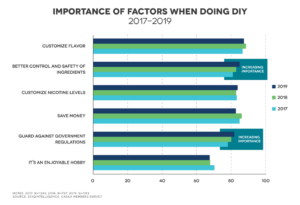Since 2016 CASAA has been working cooperatively with ECigIntelligence, assisting them with their annual US survey of people who vape. As many CASAA members participated in this survey, we are presenting the results from the 2019 data here.
DEMOGRAPHICS
The charts below illustrate the changes over time among survey participants, starting in 2016. The most notable findings are that female participation in the survey has increased since 2016, and participation from the youngest age group (18-20 years old) has decreased. This does not mean that fewer young adults are vaping, but may indicate they are less engaged with CASAA and this survey.
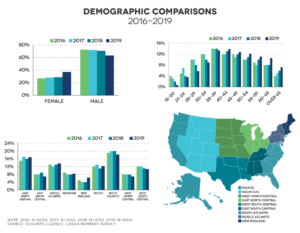
The data shows that the ratio of dual users – while not high to begin with – has been gradually decreasing, and that the number of participants using smaller, pod-like devices as their primary device has been increasing over the past two years.
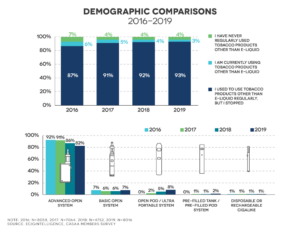
FLAVORS
The graphs below illustrate participants’ flavor preferences by year and by age group. The Fruits and Sweets/Candy flavor categories have increased the most in popularity since 2016 and they, along with Desserts/Bakery flavors, are among the most preferred flavors across all age groups.
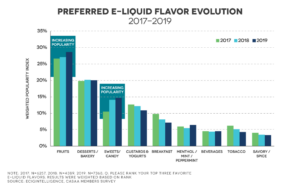
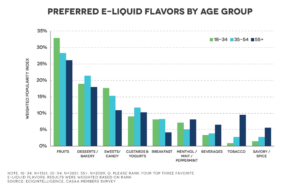
While the above graph shows that adults 55+ are more likely to use tobacco flavor than younger adults, another view of the same data clearly shows that adults 55+ (indeed, ALL age groups) still prefer fruit and other flavors over tobacco flavor.
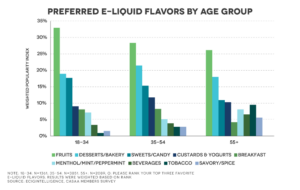
The popularity of Tobacco flavors, while fairly low to begin with, has been decreasing. 77% of participants said they did not like Tobacco flavors at all. The dislike of Tobacco flavors was about equal between men and women, and the majority of all age groups dislike them as well, with participants aged 55+ being the most likely to enjoy them.
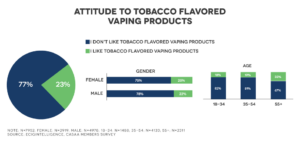
Participants were also asked what they would do in order to keep using their favorite flavors in the event they are banned or removed from the legal market. The overwhelming majority of participants (almost 70%) said they would try to acquire their flavors from alternative methods and sources ranging from making the flavored e-liquid themselves to searching for them on the illicit market. 8% of participants indicated they would return to a combustible tobacco product if flavors were banned – especially among people living in cities with stricter vaping regulations. In cities with more lenient vaping regulations, participants are more likely to use the limited flavors available (tobacco/menthol) or quit vaping completely.
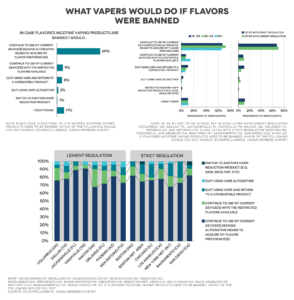
When asked how far they would be willing to travel in order to get their favorite flavors, many participants (nearly 30%) were unsure; however, more than 25% said they would be willing to travel over 100 miles to get them. Motivation plays a large role in participants’ willingness to travel, as results indicate people who want to vape in order to not smoke cigarettes and people who want to avoid putting their loved ones at risk of second hand smoke are willing to travel the furthest. Additionally, the longer participants have been vaping instead of smoking, the more willing they are to travel to get their products.
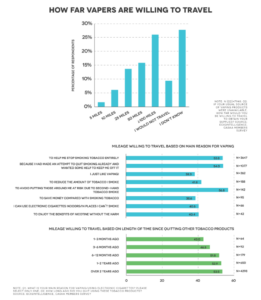
DIY
Survey participants were also asked about making their own flavored liquids at home, especially if flavors were banned from the legal market. The results showed an increase of 12 percentage points over the previous year of people who strongly agreed that they would mix their own liquids if flavors were prohibited, especially those in the younger age groups.
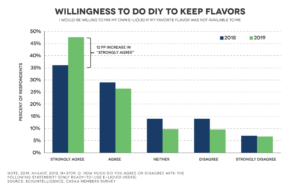
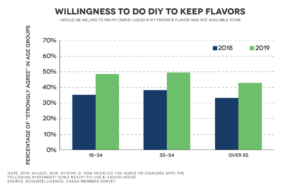
The overall popularity of DIYing has gradually decreased over the past few years across both genders and all age groups.
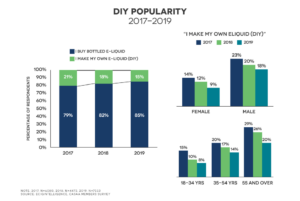
When asked about reasons why participants DIY liquid instead of purchasing it premade, two responses have increased since 2017: “Better control and safety of ingredients,” as well as “guard against government regulations.”
